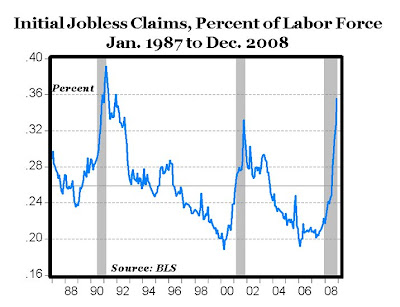 ASSOCIATED PRESS -- The Labor Department reported today that initial jobless benefit claims rose to a seasonally adjusted 589,000 in the week ending Jan. 17, from an upwardly revised figure of 527,000 the previous week. The latest tally was well above Wall Street economists' expectations of 540,000 new claims. The total matches a 26-year high reached four weeks ago. The last time claims were higher was in November 1982, when the economy was emerging from a steep recession, though the work force has grown by about half since then.
ASSOCIATED PRESS -- The Labor Department reported today that initial jobless benefit claims rose to a seasonally adjusted 589,000 in the week ending Jan. 17, from an upwardly revised figure of 527,000 the previous week. The latest tally was well above Wall Street economists' expectations of 540,000 new claims. The total matches a 26-year high reached four weeks ago. The last time claims were higher was in November 1982, when the economy was emerging from a steep recession, though the work force has grown by about half since then.MP: The chart above from 1987 to 2008 shows why comparisons of unemployment claims today to past years are meaningless, without adjusting for the change in labor force. In the last 22 years, the U.S. labor force (blue line) has increased by 30%, from about 119 million in 1987 to more than 154 million today.
The chart below shows initial jobless claims as a percent of the labor force, to adjust for the increase over time in the population and labor force. December's 0.355% level (549,000 average weekly claims / 154,447,000 labor force) is above the 0.333% peak at the end of the 2001 recession, but still way below the 0.3915% peak of the 1990-1991 recession. (Note: The January labor force number has not been released, but the average jobless claims so far in January (522,500 on a 4-week moving average basis) are actually lower than December's 549,000 number, so the January figure for jobless claims as a percent of labor force could be lower than December.) Bottom Line: Adjusted for the size of the labor force, unemployment claims haven't even yet reached the level of 1990-1991 recession. So before we make exaggerated claims of the "worst economy since the Great Depression©" we might first make comparisons to the 1990-1991 recession, and it's still not yet as bad today as it was in the early 1990s. Calculated Risk uses a longer dataset that includes the 1970s and early 1980s, showing the same thing - we've got a long way to go before today's economic conditions come close to matching previous recessions of the 1970s and 1980s.
Bottom Line: Adjusted for the size of the labor force, unemployment claims haven't even yet reached the level of 1990-1991 recession. So before we make exaggerated claims of the "worst economy since the Great Depression©" we might first make comparisons to the 1990-1991 recession, and it's still not yet as bad today as it was in the early 1990s. Calculated Risk uses a longer dataset that includes the 1970s and early 1980s, showing the same thing - we've got a long way to go before today's economic conditions come close to matching previous recessions of the 1970s and 1980s.






No comments:
Post a Comment